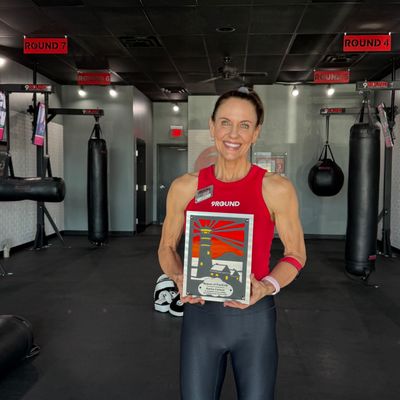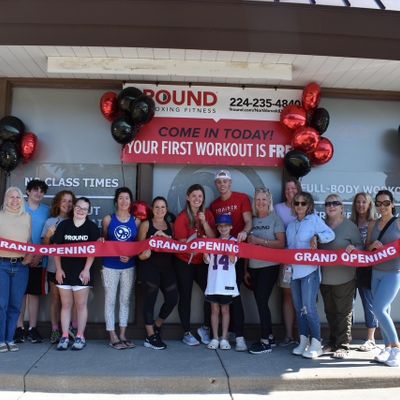Weights 101 - Choosing Your Starting Weights

At 9Round, there’s nothing we love more than seeing our members grow stronger with each 30-minute workout. Strength training is incorporated into every round to help you build lean muscle, but where it’s easiest to recognize is at Round 2. This is where you’ll find a rack of dumbbells, kettlebells, medicine balls, and other functional equipment which are used throughout the 9Round workout. With the varying sizes and shapes of each piece of equipment, it can be difficult to know what you should be reaching for before the bell rings.
We want to make weight training less intimidating the next time you step up to the mat, so we’re excited to kick off a brand series of blogs called Weights 101. Throughout this series, we’ll be answering the common questions we hear every day, like how to choose your starting weights and when to upgrade to the next level. So, keep reading and stay tuned for more tips and advice over the next few weeks.
How to Choose Your Starting Weights
Finding the perfect starting weights to work toward your #strengthgoals can be challenging if you’re not sure what to look for, but there’s an easy method to determine what level of weights you should be using, as well as when it’s time to increase your weights. Follow along as we discuss how to select the right starting weights for your KILLER workout.
Think About Your Goals
The first step to finding your starting weights is to think about your fitness goals and what you want to accomplish. This will help you determine not only how heavy your weights should be, but also how many reps you’ll be aiming to do with each move. Examples of goals you might want to achieve could be to build overall strength, to increase muscle size and definition, or to increase endurance. Each of these goals will challenge you to complete a different number of reps with a different set of weights.
- For building strength, you’ll want to do more sets of fewer reps with longer rest between each set
- For increasing muscle size and definition, you’ll want to do sets of 6-12 reps
- For increasing endurance, the recommended numbers are 12-20 reps per set
Once you know your goal for strength training, then you can follow this tip to select the right starting weights: look for weights that are challenging enough you feel like you can only do a few more reps at the end of your set, but not too challenging that you sacrifice form and feel like giving out at any moment.
If you can find weights that fit this description, then you can start making progress on your strength goals early on without feeling like the wheels aren’t turning or that you’re overloading your body too quickly. At 9Round, with our 3-minute rounds, you typically perform multiple exercises, so a middle-of-the-road approach to weights is typically a good option since you’re doing several reps in a shorter period of time.
Remember, Not All Muscles Are the Same
Your major muscle groups are going to be stronger and handle more weight compared to some of your smaller ones, mostly due to the muscles’ size and daily load. This means you’ll probably change weights when you switch targets to accommodate the amount of stress certain muscle groups can handle while strength training.
For example, your leg muscles can carry a lot more weight compared to your arm muscles because they’re already transporting a heavier load throughout the day (a.k.a. your entire upper body). This means you’ll likely have to introduce heavier weights during exercises that use your leg muscles to keep building strength in those areas.
Another example of where you might need to change weights is switching from upper arm exercises to moves that target your shoulders instead. These smaller muscles don’t get nearly as much action as your upper arm muscles do throughout the day, which means it’ll take less weight to overload them for strength training. Therefore, your Champion Trainers will likely point you toward lighter weights for moves like lateral raises or reverse flies and then heavier weights for moves like bicep curls.
The key point here is that you need to be aware of what muscles groups you’re targeting during exercise so you can choose weights not only based on the goal you’ve selected from above, but also what part of the body you’re training.
Keep a Check on Your Form
Bad exercise form can lead to a higher risk of injury. It can also prevent you from targeting the right muscles during a particular move. For example, when you do squats with weights, it’s common for people to lean too far forward when they’re using weights that are too heavy. Leaning forward increases your chance of injury when it comes to the lower back and knees, whereas maintaining a neutral spine and evenly distributing the weight on your feet helps increase form and decrease the risk of injury.
It’s easy for you to select starting weights that feel okay when you’re using them during certain moves, but they might be causing you to compromise your exercise form. The simple fix for this issue is to always be cautious of your exercise form and regularly check in throughout your workout to make sure things aren’t getting off track.
Pro Tip: Your 9Round studio doesn’t have mirrors on the wall just so you can check yourself out during the workout, but so you can check your form during each exercise to make sure you’re CRUSHING every move like a champ.
Some signs that might point to your weights being too heavy include feeling like your range of motion is limited, that your body is leaning too far forward or backward to accommodate the weight, and that your knees are buckling as you perform the move. All of these things point to a lack of exercise form and could indicate that your weights are too heavy.
The best part about 9Round is that your Champion Trainers are always there to help you select the right starting weights, and they’ll also make sure to challenge you with a heavier load if it looks like the round is too easy for you. Come see how 9Round helps members grow stronger in just 30 minutes with a free session at your local studio!
This article was written in conjunction with our certified 9Round Exercise and Nutrition Specialist, MacKenzie Rowand, CSCS, NASM-CNC.


